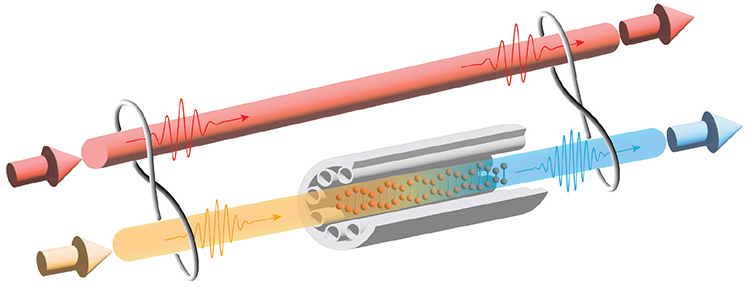 Sketch of the quantum-correlation-preserving frequency up-conversion of the idler photon of an entangled pair.
Sketch of the quantum-correlation-preserving frequency up-conversion of the idler photon of an entangled pair.
A second quantum revolution is now underway, in which quantum mechanics is moving from laboratory curiosity to real-world tool—for example, in sophisticated quantum networks.1 The success of this revolution crucially depends on technologies capable of addressing long-standing challenges in quantum optics, where solutions have so far remained elusive. An example is quantum frequency conversion of single photons and entangled pairs. Most current approaches for this function are inefficient, offer only small frequency shifts and limited tunability, and suffer from difficult-to-suppress noise introduced by the materials used.
We recently reported a breakthrough that goes a long way toward meeting these challenges, using hydrogen-filled anti-resonant-reflecting photonic crystal fiber (ARR-PCF).2 Raman scattering by random molecular vibrations is commonly thought of as an unwanted noise source that degrades the quality of nonclassical light sources. It is less well appreciated that, if a coherent pattern of molecular vibrations is first prepared, it can be used for threshold-less up-conversion of single photons. Gas-filled hollow-core ARR-PCF, which offers unique pressure-tunable dispersion,3 is the perfect vehicle for realizing this idea.
In our experiments, we first prepared a coherence wave of molecular motion by stimulated Raman scattering in hydrogen-filled ARR-PCF, and then used it to demonstrate a correlation-preserving quantum frequency conversion of 125 THz in the idler photon of an entangled pair. We not only reported efficiencies as high as 70%, but also showed that the fragile quantum correlations present in the original entangled pair are preserved.
The approach we demonstrated elegantly combines quantum optics, nonlinear fiber optics and molecular physics into a novel tool—one that is in principle fully reconfigurable and can operate at any spectral band from ultraviolet to mid-infrared. The results go well beyond the state-of-the-art in nonlinear quantum photonics by offering a means of unprecedented versatility for achieving highly efficient correlation-preserving frequency conversion of quantum light at arbitrary wavelengths. The study also opens up the prospect of a new family of fiber-based light tools with wide-reaching implications in modern quantum technologies, such as long-distance communications and quantum-enhanced imaging.
Researchers
R. Tyumenev,* J. Hammer and P. St.J. Russell, Max-Planck Institute for the Science of Light, Erlangen, Germany
N.Y. Joly, Max-Planck Institute for the Science of Light and Friedrich-Alexander-Universität, Erlangen, Germany
D. Novoa, University of the Basque Country (UPV/EHU) and Ikerbasque, Bilbao, Spain, and Max-Planck Institute for the Science of Light, Erlangen, Germany
*Present address: Interherence GmbH, Erlangen, Germany
References
1. H.J. Kimble, Nature 453, 1023 (2008).
2. R. Tyumenev et al. Science 376, 621 (2022).
3. P. St.J. Russell et al. Nat. Photon. 8, 278 (2014).
